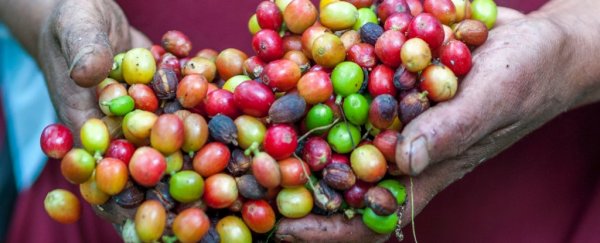The future of coffee production is looking darker than the contents of your morning cup of joe. A deadly combination of climate change, disease and deforestation is gradually pushing a multi-billion-dollar industry right to the edge.
Researchers at UK's Kew Gardens have calculated that out of the 124 coffee species known to science, nearly 60 percent are at risk of extinction.
In some areas of the world, the situation is especially dire. Over 71 percent of wild coffee species found in Madagascar and the Indian Ocean, for instance, are threatened.
"Overall, the fact that the extinction risk across all coffee species was so high - nearly 60 percent - that's way above normal extinction risk figures for plants," lead author Aaron Davis, head of coffee research and plant resources at Kew, told AFP.
"It's up there with the most endangered plant groups."
Using the latest computer modelling techniques, Davis and his team have figured that some 75 coffee species are threatened with extinction. Of that number, 13 species have been classed as critically endangered, 40 as endangered, and 22 as vulnerable.
Obviously, not all of these species are responsible for the coffee that ends up in our mugs each morning, but in nature, genetic diversity is a crucial ingredient for continued existence.
Right now, the world relies on just two species to get their caffeine fix: arabica (Coffea arabica) and robusta (C. canephora), both of which have been cultivated for hundreds of years.
Arabica, which has been harvested for millennia in Ethiopia and South Sudan, is without question the most popular, making up roughly 60 to 70 percent of all coffee sales worldwide.
Now, however, thanks to deforestation and its sensitivity to climate change, it too has been listed as endangered.
"Ethiopia is the home of arabica coffee," Tadesse Woldermariam Gole, who studies how climate change is impacting coffee at the Forest Forum, told Phys.org.
"Given the importance of arabica coffee to Ethiopia, and the world, we need to do our utmost to understand the risks facing its survival."
Looking back at climate data in Ethiopia for the last four decades, the team from Kew were able to measure how quickly deforestation, drought and disease are chipping away at this coffee bean's natural habitat.
For hundreds of years, farmers have been using wild relatives to buttress the arabica crop. Given the sensitivity of this plant to climate change, disease and pests, we will probably need to draw on this technique once again.
But without the ability to tap into the beneficial genes of their wild relatives, the arabica crop and the robusta crop may not survive for long.
"Many protected areas fail to conserve the diversity encompassed within their borders, and workable management plans would be required to ensure that target species are effectively conserved," the authors write.
Still, it's not all doom and gloom. We have a chance to fix this if we act quickly, expanding and protecting the plant's natural habitat, while ensuring its genetic diversity.
Coffee drinkers everywhere will be relieved to know that there is no current shortage of coffee, but unless something changes, a scarcity is all too possible in the near future.
A 2016 report commissioned by Fairtrade Australia & New Zealand predicted that in just a few decades, climate change could cut coffee production by up to 50 percent, hurting both consumers of coffee and farmers of the crop.
"As a coffee drinker you don't need to worry in the short term," assures Davis.
"What we are saying is that in the long term if we don't act now to preserve those key resources we don't have a very bright future for coffee farming."
If we do nothing at all, one of the world's favourite beverages might one day come to a bitter end.
This study has been published in Science Advances.
